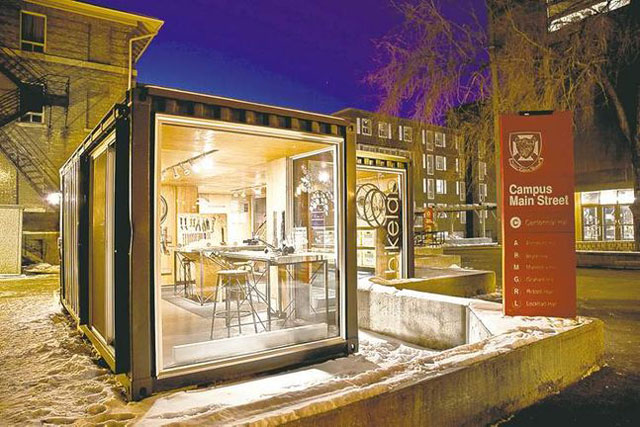
Moonlight sparkled on the water as a sleek new cargo ship backed away from her Vancouver dock and quietly slipped into the dark November night. Without ceremony, the Clifford J. Rodgers set sail for the Yukon carrying a shipment of beer, stored for the first time in a series of specially fabricated stacking metal containers. On that autumn night in 1955, she became the first cargo ship in the world to use this revolutionary technology that would transform the global economy in the 20th century.
Today, 90 per cent of the world's cargo is transported in standardized shipping containers, with more than 20 million containers making 200 million trips each year.
Architect David Penner is creatively exploring the use of shipping containers in a proposed new rental housing development at 956 Notre Dame Ave.
International trade deficits mean that less than three-quarters of the shipping containers coming to North America head back in the opposite direction. This has led to a surplus of tens of thousands of containers sitting unused in ports across the continent.
The growing importance of environmental sustainability in building design has led architects to explore these mountains of unused steel boxes as a material resource. With prefabricated and modular construction reducing labour, fabrication time and material waste, reclaiming discarded shipping containers can be an effective and affordable component of a sustainable design strategy.
Constructed with standardized dimensions and interlocking connections that allow stacking of up to 12 units, shipping containers that are built to carry heavy loads and withstand harsh environments can be a versatile design module for many building types. They have been used for everything from temporary housing for Japanese tsunami victims to a dramatic London hotel, a 1,000-container student residence in Amsterdam and even a Starbucks in Seattle.
As construction costs continue to rise, some Winnipeg architects are looking to shipping-container design as an economically attractive alternative to standard construction.
Despite high demand and low vacancy rates, the shortage of new residential apartment development occurring in Winnipeg can be attributed in large part to an imbalance between construction costs and rental rates, making investment less attractive to developers. Architect David Penner is creatively exploring the use of shipping containers in a proposed new rental-housing development at 956 Notre Dame Ave., as a way to close this financial disparity.
The project proposes to use a total of 36 containers stacked three across and six high, plugged into a central exterior circulation core from two sides. The efficient unit configuration takes advantage of the built-in structural capabilities of the containers, reducing cost and simplifying construction.
Each of the 18 residential units consists of two stacked containers that form a 37-square-metre (400-square-foot) double-height loft apartment. With a standard width of only 2.4 metres, the stacked layout increases the volume of interior space to create a sense of openness and provides the opportunity for a full-height glass end wall that floods the unit with natural light.
If this innovative project successfully solves the technical challenges of this construction type in our climate, it will lay the groundwork for community and government acceptance of other container buildings that could help meet the provincewide need for affordable quality housing.
On the campus of the University of Winnipeg, a new shipping-container building stands as an example of how recycled industrial waste can be creatively transformed into a sophisticated piece of modern urban architecture.
Designed by Peter Sampson Architecture Studio, bikelab is a community-focused educational bicycle repair kiosk that combines two storage containers that once travelled the oceans with an Italian shipping company. The units were prefabricated and bolted together after being transported to the site. Sitting on a foundation of temporary concrete blocks, its light footprint and modular construction mean the building can be easily dismantled, placed on a truck and reconfigured at another site. This versatility will potentially extend its life cycle, allowing it to adapt to evolving conditions.
A discarded heavy transportation relic finding new life celebrating modern active transportation is a poetic design metaphor that brings a creative spirit to the building. The innovative use of shipping containers, however, provided the more practical advantages of allowing the project to meet its budget constraints and its environmental sustainability goals while expressing a functional simplicity and esthetic elegance.
Bikelab serves as a welcoming meeting place on the University of Winnipeg campus, with light pouring out of large glass openings cut into the container sides, exposing the warm recycled-wood interior. Its success and efficiency make bikelab an appropriate design prototype for similar facilities envisioned as beacons across the campus and even linking to transportation pathways throughout the city.
Shipping-container architecture is a growing trend around the world, but bringing it to the context of an extreme Manitoba climate presents unique challenges. The innovative strategies demonstrated with these two projects exemplify some of the creative architectural design happening in Winnipeg today. Their clever solutions promote the importance of environmental responsibility while at the same time expressing a modern urban flair.
Brent Bellamy is senior design architect for Number Ten Architectural Group. Email him at bbellamy@numberten.com
Republished from the Winnipeg Free Press print edition March 5, 2012 B6

